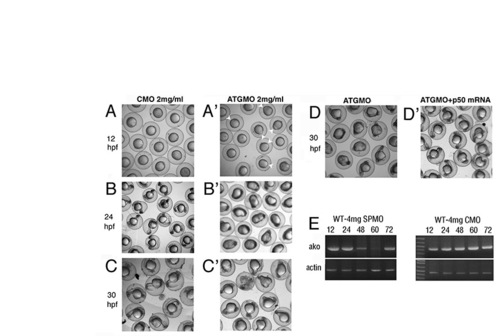
ako is supplied maternally. (A,A′) Control morpholino injection has no effect on development (A), whereas anti-ATG morpholino against the dynactin 2 gene results in a delayed epiboly (A′). In many embryos, yolk plug closure is not completed even at 12 hpf (white arrowheads in A′). (B,B′) By 24 hpf, the yolk is abnormally elongated, the tail region is severely stunted, and cell death appears to be abundant along the entire body axis of dynactin 2 morphants (B′, compare to control morpholino-treated embryos in B). (C,C′) Similarly, embryonic development shows severe defects in morphants at 30 hpf (C′, compare with C). (D,D′) These defects are rescued by ako mRNA injections at 30 hpf (D′, compare with D). (E) RT-PCR amplification of the ako transcript from control (CMO) and splice-site (SPMO) morpholino-treated embryos. Actin amplification is used as a control. In SP morpholino-treated embryos, ako mRNA can be efficiently amplified at 12 and 24 hpf, but not at 48 and 60 hpf, indicating the presence of maternally contributed transcript at early stages of embryogenesis. The transcript is detected again at 72 hpf, presumably because of a decrease of knockdown efficiency.
|

